Optimal Low-Carbon Economic Environmental Dispatch of Hybrid Electricity-Natural Gas Energy Systems Considering P2G
Abstract
1. Introduction
2. Problem Formulation
2.1. Optimal Economic Environmental Dispatch of Power System
2.1.1. Objectives
2.1.2. Constraints
- (1)
- Power Output Limitswhere and represent the minimum power output and maximum power output of unit i, respectively.
- (2)
- Ramp Rate Limitswhere and represent the ramp up rate and the ramp down rate of unit i, respectively.
- (3)
- Line Capacity Limitwhere is the maximum capacity of line l.
2.2. Optimal Low-Carbon Economic Dispatch of Natural-Gas System Considering P2G
2.2.1. Objectives
2.2.2. Constraints
2.3. Gas Demand Management Strategy to Coordinate the Two Energy Systems
2.4. Constraints Handling Methods
2.4.1. Equality Constraints Handling Method
2.4.2. Inequality Constraints Handling Method
- a)
- For gas storage m at time t;
- b)
- If Vm(t) ≤ , calculate ΔV = − Vm(t);
- c)
- For ii = 1:t, calculate the gas flow redundancy of gas storage m at time ii. ΔQgs(ii) = min{ − Qgs,m(ii), − Vgs,m(ii)}. If the gas node where the gas storage m is connected with P2G, ΔQP2G(ii) = − QP2G(ii), the effective redundancy ΔQ(ii) = min{ΔQgs(ii), ΔQP2G(ii)}; else, ΔQ(ii) = ΔQgs(ii). Then, arrange ΔQ in descending order;
- d)
- According to the descending order, QP2G(ii) and Qgs,m(ii) are adjusted successively until Vm(t) ≥ ;
- e)
- Update Vm(t);
- f)
- If Vm(t) ≥ , calculate ΔV = Vm(t) − ;
- g)
- For ii = 1:t, calculate the gas flow redundancy of gas storage m at time ii. ΔQgs(ii) = min{Qgs,m(ii) – , Vgs,m(ii) − }. If the gas node where the gas storage m is connected with P2G, ΔQP2G(ii) = QP2G(ii) − , the effective redundancy ΔQ(ii) = min{ΔQgs(ii), ΔQP2G(ii)}; else, ΔQ(ii) = ΔQgs(ii). Then, arrange ΔQ in descending order;
- h)
- According to the descending order, QP2G(ii) and Qgs,m(ii) are adjusted successively until Vm(t) ≤ ;
- i)
- Update Vm(t).
3. Case Studies Application
3.1. Description of Case Studies
3.2. Analysis of Simulation Results
3.2.1. Effects of P2G on the Power System
3.2.2. Effects of P2G on the Natural-gas System
3.2.3. Total Cost Reduction of the Hybrid Energy Systems
4. Conclusions
Author Contributions
Funding
Acknowledgments
Conflicts of Interest
Appendix A
| Node No. | 1 | 2 | 3 | 4 | 5 | 6 | 7 | 8 | 9 | 10 |
| Hour 1 | 74.7469 | 73.8385 | 72.5356 | 56.7444 | 45.5189 | 41.0362 | 42.8709 | 43.8394 | 55.7467 | 61.3213 |
| Hour 2 | 67.0635 | 66.5001 | 65.6495 | 55.1170 | 39.9237 | 38.1803 | 40.9818 | 45.8246 | 50.2401 | 55.2641 |
| Hour 3 | 70.9782 | 70.6287 | 69.6258 | 56.8556 | 53.1330 | 46.9431 | 47.4426 | 40.3510 | 54.5096 | 59.9605 |
| Hour 4 | 67.7032 | 67.1715 | 66.3961 | 57.2499 | 70.7133 | 54.9508 | 54.2037 | 42.9448 | 53.3986 | 58.7385 |
| Hour 5 | 60.3126 | 59.8906 | 59.2212 | 51.7346 | 33.9220 | 33.5808 | 37.1390 | 46.9318 | 49.9918 | 54.9910 |
| Hour 6 | 60.2348 | 60.0091 | 59.2823 | 51.2112 | 48.2071 | 40.7850 | 41.2236 | 44.1951 | 50.0255 | 55.0280 |
| Hour 7 | 61.7065 | 61.2190 | 60.5111 | 52.7660 | 56.6407 | 46.2672 | 46.2665 | 44.8522 | 51.1059 | 56.2164 |
| Hour 8 | 72.0210 | 71.2920 | 70.1714 | 55.5450 | 30.7629 | 30.7596 | 37.3143 | 40.5826 | 50.3482 | 55.3830 |
| Hour 9 | 59.6538 | 59.2193 | 58.5192 | 50.4304 | 63.6206 | 46.3675 | 45.9280 | 38.7845 | 52.4694 | 57.7163 |
| Hour 10 | 63.8376 | 63.4229 | 62.5894 | 52.8985 | 40.6647 | 38.5312 | 40.3515 | 45.1444 | 53.4969 | 58.8466 |
| Hour 11 | 70.6866 | 69.9749 | 68.8971 | 54.9136 | 27.6230 | 27.5911 | 35.2202 | 41.7990 | 50.9478 | 56.0425 |
| Hour 12 | 68.9173 | 68.3366 | 67.3818 | 55.2606 | 41.9605 | 38.5358 | 40.9826 | 43.4697 | 52.3659 | 57.6024 |
| Hour 13 | 64.6456 | 64.1633 | 63.3132 | 52.9436 | 32.3582 | 31.5162 | 36.1046 | 44.7830 | 50.4011 | 55.4412 |
| Hour 14 | 68.1243 | 67.1946 | 66.2050 | 53.6897 | 45.2849 | 40.2787 | 41.5617 | 39.2924 | 51.8961 | 57.0857 |
| Hour 15 | 77.3472 | 76.3396 | 75.1040 | 58.2513 | 28.6262 | 28.7076 | 37.7480 | 40.5386 | 50.1422 | 55.1564 |
| Hour 16 | 74.0179 | 73.6698 | 72.5552 | 57.3796 | 36.5834 | 35.4363 | 40.2615 | 40.3234 | 50.9462 | 56.0408 |
| Hour 17 | 72.7026 | 71.9010 | 70.8103 | 56.1345 | 35.5315 | 34.6661 | 39.3576 | 39.7726 | 50.2135 | 55.2349 |
| Hour 18 | 75.1341 | 74.3651 | 73.1955 | 57.2444 | 37.5240 | 36.4759 | 40.8464 | 38.1481 | 50.2537 | 55.2791 |
| Hour 19 | 70.4893 | 69.9243 | 68.9806 | 56.8986 | 63.1603 | 51.1618 | 51.1398 | 38.1952 | 53.7179 | 59.0897 |
| Hour 20 | 90.0790 | 89.4097 | 87.8955 | 66.0627 | 30.6166 | 32.7061 | 44.5817 | 38.5313 | 51.2693 | 56.3962 |
| Hour 21 | 72.9250 | 72.4852 | 71.4642 | 57.2781 | 44.5136 | 41.6715 | 44.0290 | 38.2162 | 56.4074 | 62.0482 |
| Hour 22 | 69.5078 | 68.3668 | 67.3470 | 53.8900 | 37.1964 | 35.8036 | 39.0643 | 38.5332 | 54.3579 | 59.7937 |
| Hour 23 | 70.0484 | 69.6090 | 68.6537 | 56.6512 | 59.8959 | 49.6890 | 49.7032 | 40.4218 | 53.2979 | 58.6277 |
| Hour 24 | 56.7456 | 56.3199 | 55.5790 | 46.7811 | 33.0590 | 31.2034 | 33.3676 | 38.3445 | 64.6311 | 71.0942 |
| Node No. | 11 | 12 | 13 | 14 | 15 | 16 | 17 | 18 | 19 | 20 |
| Hour 1 | 54.1081 | 50.5855 | 46.0875 | 44.7456 | 35.3047 | 25.7453 | 49.7105 | 35.4170 | 26.1208 | 25.9488 |
| Hour 2 | 51.7236 | 50.3445 | 47.8200 | 46.7134 | 37.8536 | 29.1582 | 49.9537 | 40.2191 | 31.2779 | 31.1271 |
| Hour 3 | 54.3675 | 51.3623 | 45.1763 | 40.7143 | 31.6600 | 21.1181 | 51.0356 | 43.0089 | 35.4623 | 35.3304 |
| Hour 4 | 53.8731 | 51.4255 | 46.4733 | 43.5065 | 34.3087 | 24.3816 | 51.1668 | 44.6069 | 37.9960 | 37.8745 |
| Hour 5 | 51.9467 | 50.9341 | 49.0610 | 48.4082 | 39.0532 | 30.5918 | 50.7221 | 45.1699 | 39.1410 | 39.0242 |
| Hour 6 | 51.3066 | 49.8506 | 46.9020 | 45.3095 | 36.2103 | 27.2829 | 49.6736 | 44.8413 | 39.1515 | 39.0360 |
| Hour 7 | 52.2445 | 50.6172 | 47.4860 | 45.9142 | 36.8016 | 27.8913 | 50.4070 | 45.1037 | 39.3228 | 39.2076 |
| Hour 8 | 50.8360 | 48.7091 | 44.1013 | 41.0575 | 31.8666 | 21.3437 | 48.5566 | 44.1770 | 38.6343 | 38.5179 |
| Hour 9 | 52.3018 | 49.4738 | 43.5577 | 39.5966 | 29.3700 | 17.2155 | 49.2713 | 44.1255 | 38.3480 | 38.2301 |
| Hour 10 | 54.3000 | 52.1931 | 48.2816 | 46.3746 | 36.7013 | 27.3680 | 51.9234 | 45.6230 | 39.5052 | 39.3897 |
| Hour 11 | 51.6829 | 49.6546 | 45.2476 | 42.3900 | 33.2849 | 23.2977 | 49.4998 | 44.9943 | 39.3993 | 39.2845 |
| Hour 12 | 52.9842 | 50.8287 | 46.5780 | 44.1992 | 35.0247 | 25.4320 | 50.6144 | 45.2823 | 39.5316 | 39.4170 |
| Hour 13 | 51.7051 | 50.2120 | 47.2589 | 45.8176 | 36.6459 | 27.6235 | 50.0282 | 45.1247 | 39.4647 | 39.3501 |
| Hour 14 | 51.9730 | 49.3827 | 43.7844 | 39.8147 | 30.3185 | 19.0701 | 49.2116 | 44.5565 | 38.9702 | 38.8546 |
| Hour 15 | 50.5211 | 48.3266 | 43.7034 | 40.9399 | 31.3684 | 20.1573 | 48.1649 | 43.6773 | 38.0939 | 37.9760 |
| Hour 16 | 51.1041 | 48.7023 | 43.7603 | 40.7302 | 31.1775 | 19.9426 | 48.5071 | 43.4549 | 37.6395 | 37.5197 |
| Hour 17 | 50.4220 | 48.1032 | 43.2388 | 40.2295 | 30.5039 | 18.9170 | 47.9215 | 43.0252 | 37.1790 | 37.0577 |
| Hour 18 | 50.1500 | 47.5764 | 42.0906 | 38.4792 | 28.4809 | 15.5972 | 47.3952 | 42.5038 | 36.6134 | 36.4903 |
| Hour 19 | 53.1562 | 49.8808 | 43.1425 | 38.5692 | 28.3725 | 15.1925 | 49.6243 | 43.5000 | 37.2428 | 37.1207 |
| Hour 20 | 51.1983 | 48.4743 | 42.5615 | 38.5943 | 28.7701 | 15.8577 | 48.2927 | 43.2795 | 37.3198 | 37.1984 |
| Hour 21 | 55.6171 | 51.8483 | 44.0882 | 38.5362 | 28.4171 | 15.2929 | 51.5608 | 44.9563 | 38.6616 | 38.5433 |
| Hour 22 | 54.1611 | 50.9718 | 44.0340 | 39.1087 | 28.7767 | 15.8746 | 50.7701 | 45.4186 | 39.5082 | 39.3929 |
| Hour 23 | 53.3906 | 50.6155 | 44.7480 | 40.9330 | 31.0949 | 19.5983 | 50.4247 | 45.3936 | 39.6974 | 39.5833 |
| Hour 24 | 63.3091 | 58.1787 | 47.7707 | 39.5037 | 28.7623 | 16.1240 | 57.7734 | 49.4686 | 43.0386 | 42.9313 |
References
- Mazza, A.; Bompard, E.; Chicco, G. Application of power to gas technologies in emerging electrical systems. Renew. Sustain. Energy Rev. 2018, 92, 794–806. [Google Scholar] [CrossRef]
- Hibbard, P.J.; Schatzki, T. The interdependence of electricity and natural gas: Current factors and future prospects. Electr. J. 2012, 25, 6–17. [Google Scholar] [CrossRef]
- Correa-Posada, C.M.; Sánchez-Martín, P. Integrated power and natural gas model for energy adequacy in short-term operation. IEEE Trans. Power Syst. 2015, 30, 3347–3355. [Google Scholar] [CrossRef]
- Schiebahn, S.; Grube, T.; Robinius, M.; Tietze, V.; Kumar, B.; Stolten, D. Power to gas: Technological overview, systems analysis and economic assessment for a case study in Germany. Int. J. Hydrogen Energy 2015, 40, 4285–4294. [Google Scholar] [CrossRef]
- Götz, M.; Lefebvre, J.; Mörs, F.; McDaniel Koch, A.; Graf, F.; Bajohr, S.; Reimert, R.; Kolb, T. Renewable power-to-gas: A technological and economic review. Renew. Energy 2016, 85, 1371–1390. [Google Scholar] [CrossRef]
- Maroufmashat, A.; Fowler, M. Transition of future energy system infrastructure: Through power-to-gas pathways. Energies 2017, 10, 1089. [Google Scholar] [CrossRef]
- Mukherjee, U.; Maroufmashat, A.; Narayan, A.; Elkamel, A.; Fowler, M. A stochastic programming approach for the planning and operation of a power to gas energy hub with multiple energy recovery pathways. Energies 2017, 10, 868. [Google Scholar] [CrossRef]
- Eveloy, V.; Gebreegziabher, T. A review of projected power-to-gas deployment scenarios. Energies 2018, 11, 1824. [Google Scholar] [CrossRef]
- Clegg, S.; Mancarella, P. Integrated modeling and assessment of the operational impact of power-to-gas (P2G) on electrical and gas transmission networks. IEEE Trans. Sustain. Energy 2015, 6, 1234–1244. [Google Scholar] [CrossRef]
- Department of Energy and Climate Change. The Future of Heating: Meeting the Challenge; HM Government: London, UK, 2013. [Google Scholar]
- Ball, M.B.; Wietschel, M. The Hydrogen Economy: Opportunities and Challenges; Cambridge University Press: Cambridge, UK, 2009.
- An, S.; Li, Q.; Gedra, T.W. Natural gas and electricity optimal power flow. In Proceedings of the IEEE PES Transmission and Distribution Conference and Exposition, Dallas, TX, USA, 7–12 September 2003. [Google Scholar] [CrossRef]
- Chen, S.; Wei, Z.N.; Sun, G.Q.; Wang, D.; Sun, Y.H.; Zang, H.X.; Zhu, Y. Probabilistic energy flow analysis in integrated electricity and natural-gas energy systems. Proc. CSEE 2015, 35, 6331–6340. [Google Scholar] [CrossRef]
- Sun, G.Q.; Chen, S.; Wei, Z.N.; Chen, S.; Li, Y.C. Probabilistic optimal power flow of combined natural gas and electric system considering correlation. Autom. Electr. Power Syst. 2015, 39, 11–17. [Google Scholar] [CrossRef]
- Osiadacz, A.J. Simulation and Analysis of Gas Networks; Gulf Publishing Company: Houston, TX, USA, 1987. [Google Scholar]
- Liu, C.; Shahidehpour, M.; Fu, Y.; Li, Z.Y. Security-constrained unit commitment with natural gas transmission constraints. IEEE Trans. Power Syst. 2009, 24, 1523–1536. [Google Scholar] [CrossRef]
- Geidl, M.; Andersson, Q. Optimal power flow of multiple energy carriers. IEEE Trans. Power Syst. 2007, 22, 145–155. [Google Scholar] [CrossRef]
- Qadrdan, M.; Wu, J.Z.; Jenkins, N.; Ekanayake, J. Operating strategies for a GB integrated gas and electricity network considering the uncertainty in wind power forecasts. IEEE Trans. Sustain. Energy 2014, 5, 128–138. [Google Scholar] [CrossRef]
- Chaudry, M.; Jenkins, N.; Strbac, G. Multi-time period combined gas and electricity network optimization. Electr. Power Syst. Res. 2008, 78, 1265–1279. [Google Scholar] [CrossRef]
- Wang, W.L.; Wang, D.; Jia, H.J.; Chen, Z.Y.; Guo, B.Q.; Zhou, H.M.; Fan, M.H. Steady state analysis of electricity-gas regional integrated energy system with consideration of NGS network status. Proc. CSEE 2017, 37, 1293–1304. [Google Scholar] [CrossRef]
- Odetayo, B.; Kazemi, M.; MacCormack, J.; Rosehart, W.D.; Zareipour, H.; Seifi, A.R. A chance constrained programming approach to the integrated planning of electric power generation, natural gas network and storage. IEEE Trans. Power Syst. 2018, 33, 6883–6893. [Google Scholar] [CrossRef]
- Guandalini, G.; Robinius, M.; Grube, T.; Campanari, S.; Stolten, D. Long-term power-to-gas potential from wind and solar power: A country analysis for Italy. Int. J. Hydrogen Energy 2017, 42, 13389–13406. [Google Scholar] [CrossRef]
- Liu, W.J.; Wen, F.S.; Xue, Y.S. Power-to-gas technology in energy systems: Current status and prospects of potential operation strategies. J. Mod. Power Syst. Clean Energy 2017, 5, 439–450. [Google Scholar] [CrossRef]
- He, L.C.; Lu, Z.G.; Zhang, J.F.; Geng, L.J.; Zhao, H.; Li, X.P. Low-carbon economic dispatch for electricity and natural gas systems considering carbon capture systems and power-to-gas. Appl. Energy 2018, 224, 357–370. [Google Scholar] [CrossRef]
- International Energy Agency. Prospects for Hydrogen and Fuel Cell; International Energy Agency: Paris, France, 2005. [Google Scholar]
- De Vries, H.; Florisson, O.; Tiekstra, G. Safe operation of natural gas appliances fueled with hydrogen/natural gas mixtures (progress obtained in the naturally-project). In Proceedings of the International Conference on Hydrogen Safety, San Sebastián, Spain, 11–13 September 2007. [Google Scholar] [CrossRef]
- Dodds, P.E.; Demoullin, S. Conversion of the UK gas system to transport hydrogen. Int. J. Hydrogen Energy 2013, 38, 7189–7200. [Google Scholar] [CrossRef]
- Biegger, P.; Kirchbacher, F.; Medved, A.R.; Miltner, M.; Lehner, M.; Harasek, M. Development of honeycomb methanation catalyst and its application in power to gas systems. Energies 2018, 11, 1679. [Google Scholar] [CrossRef]
- Li, Y.; Liu, W.J.; Zhao, J.H.; Wen, F.S.; Dong, C.Y.; Zheng, Y.; Zhang, R. Optimal dispatch of combined electricity-gas-heat energy systems with power-to-gas devices and benefit analysis of wind power accommodation. Power Syst. Technol. 2016, 40, 3680–3688. [Google Scholar] [CrossRef]
- Clegg, S.; Mancarella, P. Integrated electrical gas network flexibility assessment in low-carbon multi-energy systems. IEEE Trans. Sustain. Energy 2016, 7, 718–731. [Google Scholar] [CrossRef]
- Ye, J.; Yuan, R.X. Integrated natural gas, heat, and power dispatch considering wind power and power-to-gas. Sustainability 2017, 9, 602. [Google Scholar] [CrossRef]
- Li, G.Q.; Zhang, R.F.; Jiang, T. security-constrained bi-level economic dispatch model for integrated natural gas and electricity systems considering wind power and power-to-gas process. Appl. Energy 2017, 194, 696–704. [Google Scholar] [CrossRef]
- Guandalini, G.; Campanari, S.; Romano, M.C. Power-to-gas plants and gas turbines for improved wind energy dispatchability: Energy and economic assessment. Appl. Energy 2015, 147, 117–130. [Google Scholar] [CrossRef]
- Chen, Z.Y.; Wang, D.; Jia, H.J.; Wang, W.L.; Guo, B.Q.; Qu, B.; Fan, M.H. Research on optimal day-ahead economic dispatching strategy for microgrid considering P2G and multi-source energy storage system. Proc. CSEE 2017, 37, 3067–3077. [Google Scholar] [CrossRef]
- Wei, Z.N.; Zhang, S.D.; Sun, G.Q.; Zang, H.Y.; Chen, S.; Chen, S. Power-to-gas considered peak load shifting research for integrated electricity and natural-gas energy systems. Proc. CSEE 2017, 37, 4601–4609. [Google Scholar] [CrossRef]
- He, C.; Liu, T.Q.; Wu, L.; Shahidepour, M. Robust coordination of interdependent electricity and natural gas systems in day-ahead scheduling for facilitating volatile renewable generations via power-to-gas technology. J. Mod. Power Syst. Clean Energy 2017, 5, 375–388. [Google Scholar] [CrossRef]
- Shu, K.G.; Ai, X.M.; Fang, J.K.; Yao, W.; Chen, Z.; He, H.B.; Wen, J.Y. Real-time subsidy based robust scheduling of the integrated power and gas system. Appl. Energy 2019, 236, 1158–1167. [Google Scholar] [CrossRef]
- Qu, K.P.; Zheng, B.M.; Yu, T.; Li, H.F. Convex decoupled-synergetic strategies for robust multi-objective power and gas flow considering power to gas. Energy 2019, 168, 753–771. [Google Scholar] [CrossRef]
- Liu, J.; Luo, X.J. Environmental economic dispatching adopting multi-objective random black-hole particle swarm optimization algorithm. Proc. CSEE 2010, 30, 105–111. [Google Scholar] [CrossRef]
- Liu, J.; Luo, X.J. Short-term optimal environmental economic hydrothermal scheduling based on handling complicated constraints of multi-chain cascaded hydropower station. Proc. CSEE 2012, 32, 27–35. [Google Scholar] [CrossRef]
- Liu, J.; Luo, X.J. Optimal economic emission hydrothermal scheduling using a novel algorithm based on black hole theory and annual profit analysis considering fuel gas desulphurization. In Proceedings of the 1st International IET Renewable Power Generation Conference, Edinburgh, UK, 6–8 September 2011. [Google Scholar] [CrossRef]
- Liu, J.; Lu, Q.W.; Liu, Y. Optimal capacity allocation of hybrid wind-solar-battery power system containing electric vehicles. In Proceedings of the 5th International IET Renewable Power Generation Conference, London, UK, 21–22 September 2016. [Google Scholar]
- Byrd, R.H.; Gilbert, J.C.; Nocedal, J. A trust region method based on interior point techniques for nonlinear programming. Math. Program. 2000, 89, 149–185. [Google Scholar] [CrossRef]
- Mohamed Abdelmageed Abdelaziz, M.; Farag, H.E.; El-Saadany, E.F.; Mohamed, Y.A.I. A novel and generalized three-phase power flow algorithm for islanded microgrids using a newton trust region method. IEEE Trans. Power Syst. 2013, 28, 190–201. [Google Scholar] [CrossRef]
- Wilamowski, B.M.; Yu, H. Improved computation for Levenberg-Marquardt training. IEEE Trans. Neural Netw. 2010, 21, 930–937. [Google Scholar] [CrossRef]
- Kanzowa, C.; Yamashitab, N.; Fukushimab, M. Levenberg-Marquardt methods with strong local convergence properties for solving nonlinear equations with convex constraints. J. Comput. Appl. Math. 2004, 172, 375–397. [Google Scholar] [CrossRef]
- Zheng, J.; Wen, F.S.; Li, L.; Wang, K.; Gao, C. Transmission system expansion planning considering combined operation of wind farms and energy storage systems. Autom. Electr. Power Syst. 2013, 37, 135–142. [Google Scholar] [CrossRef]
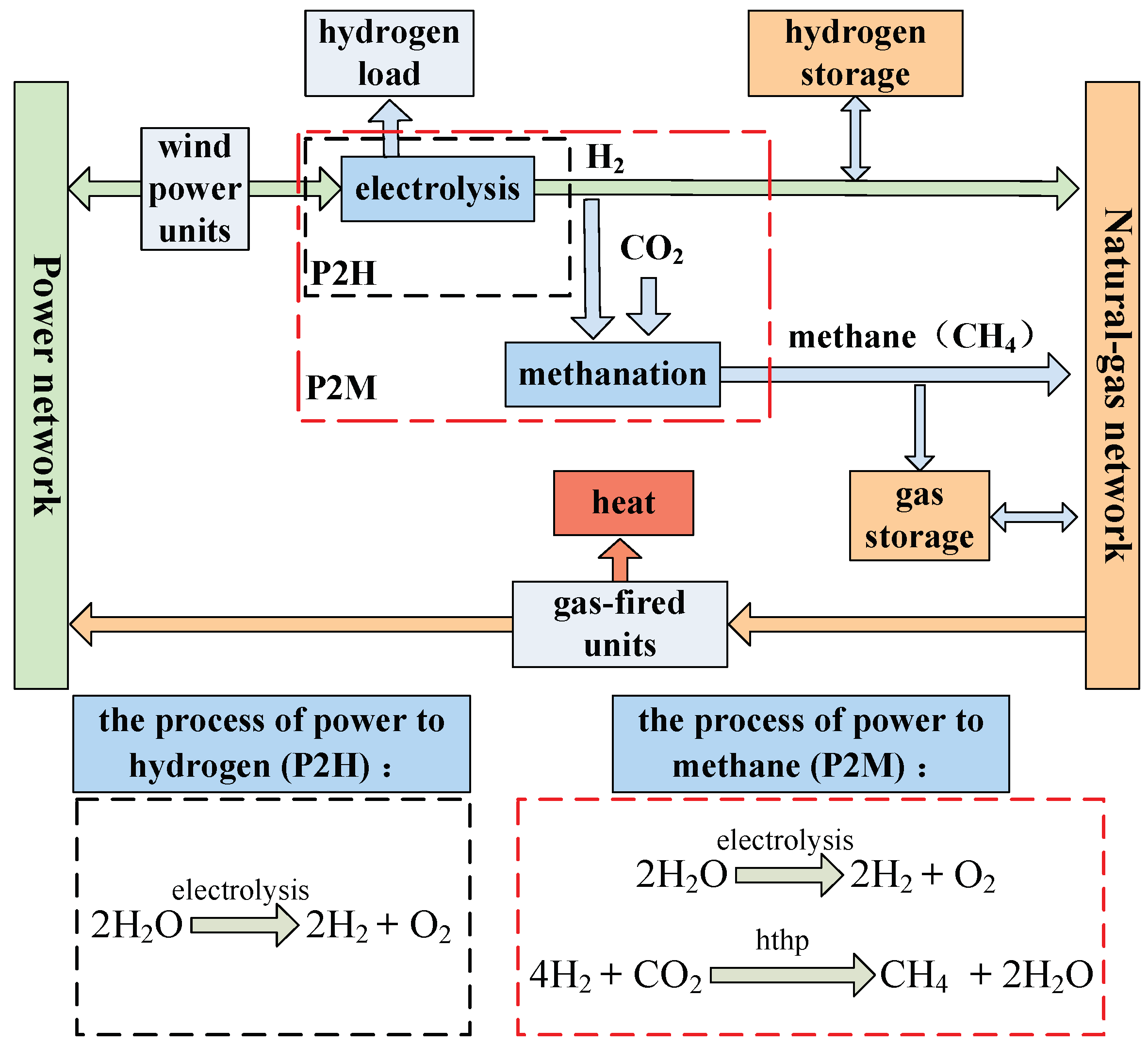



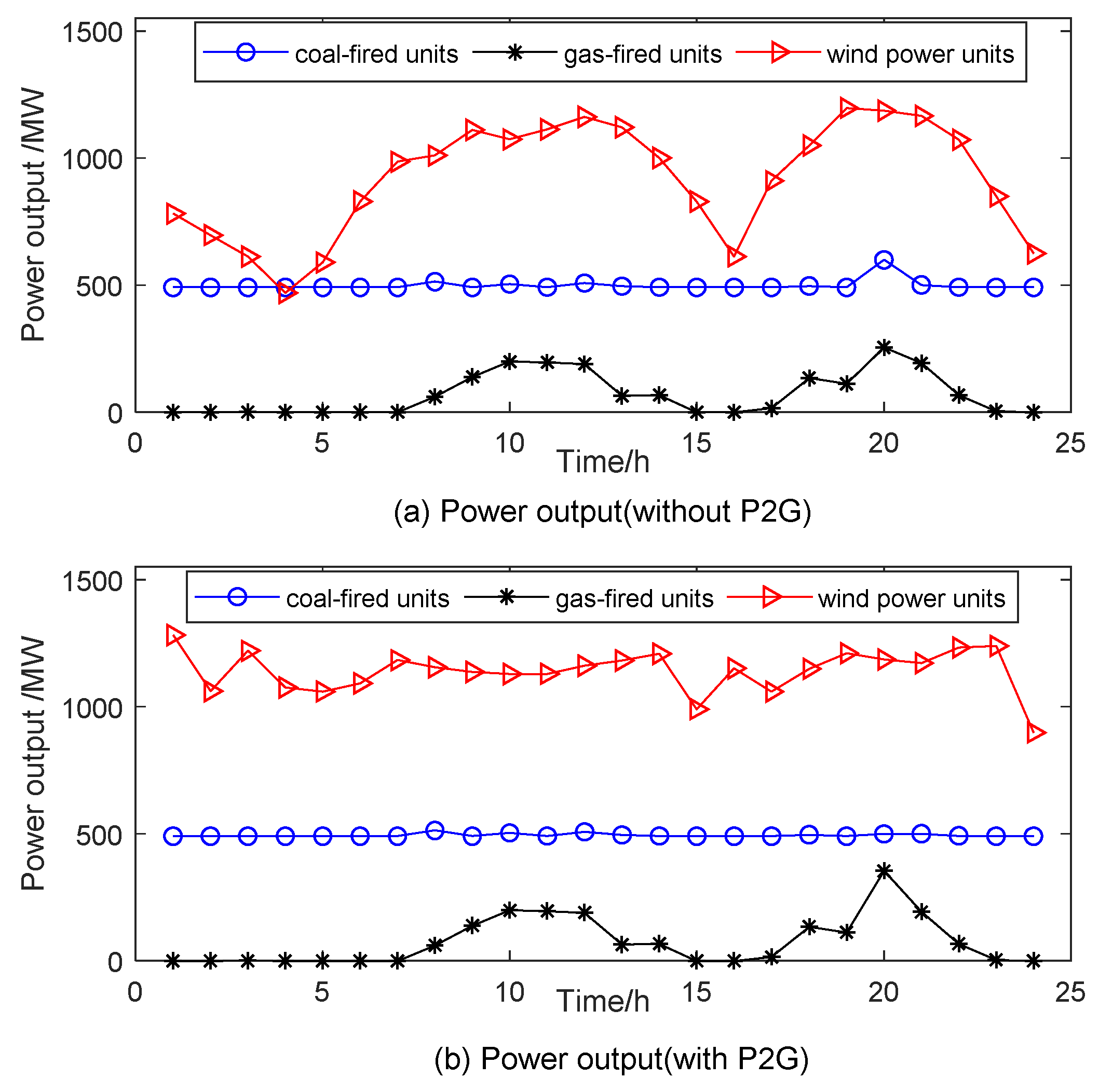
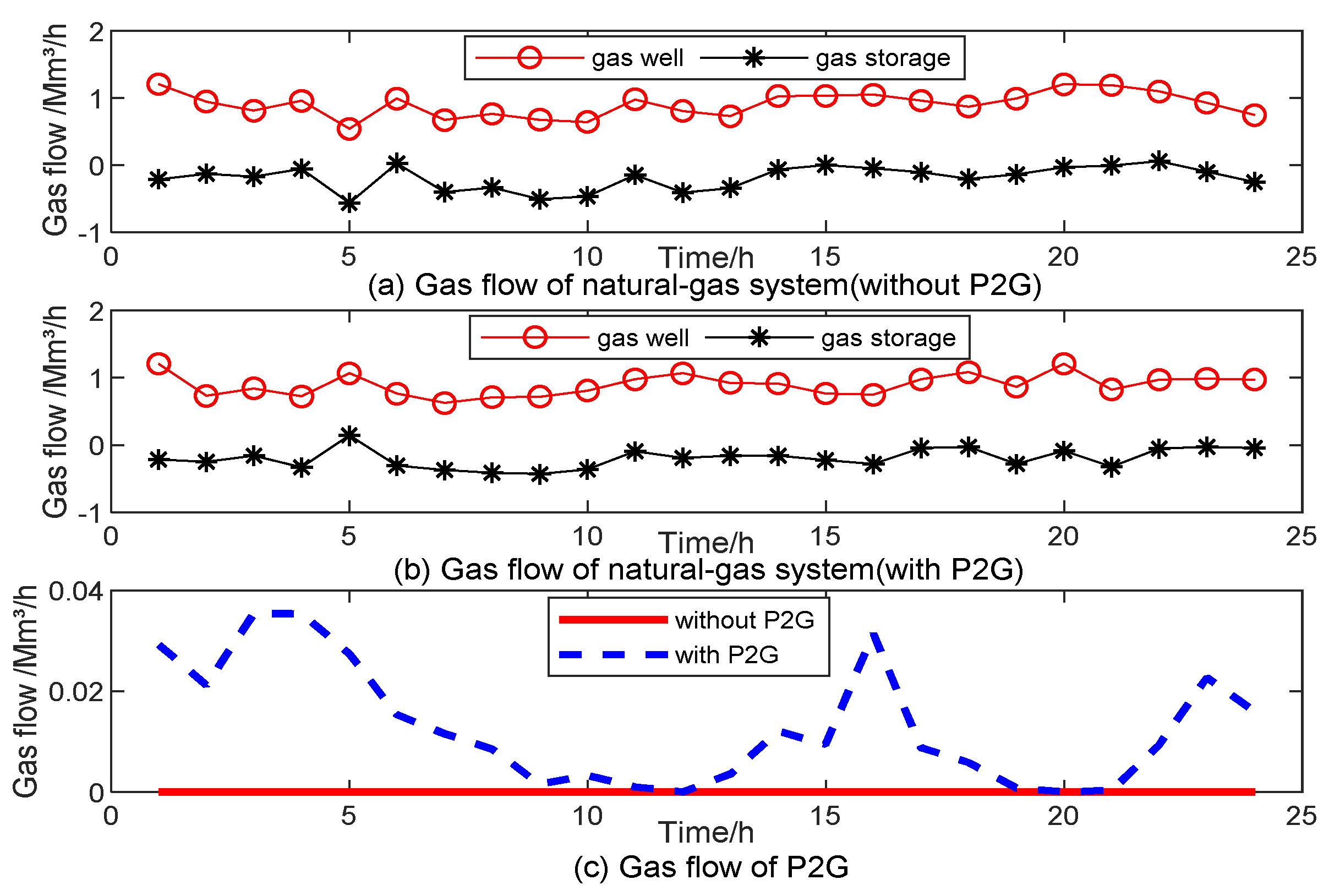
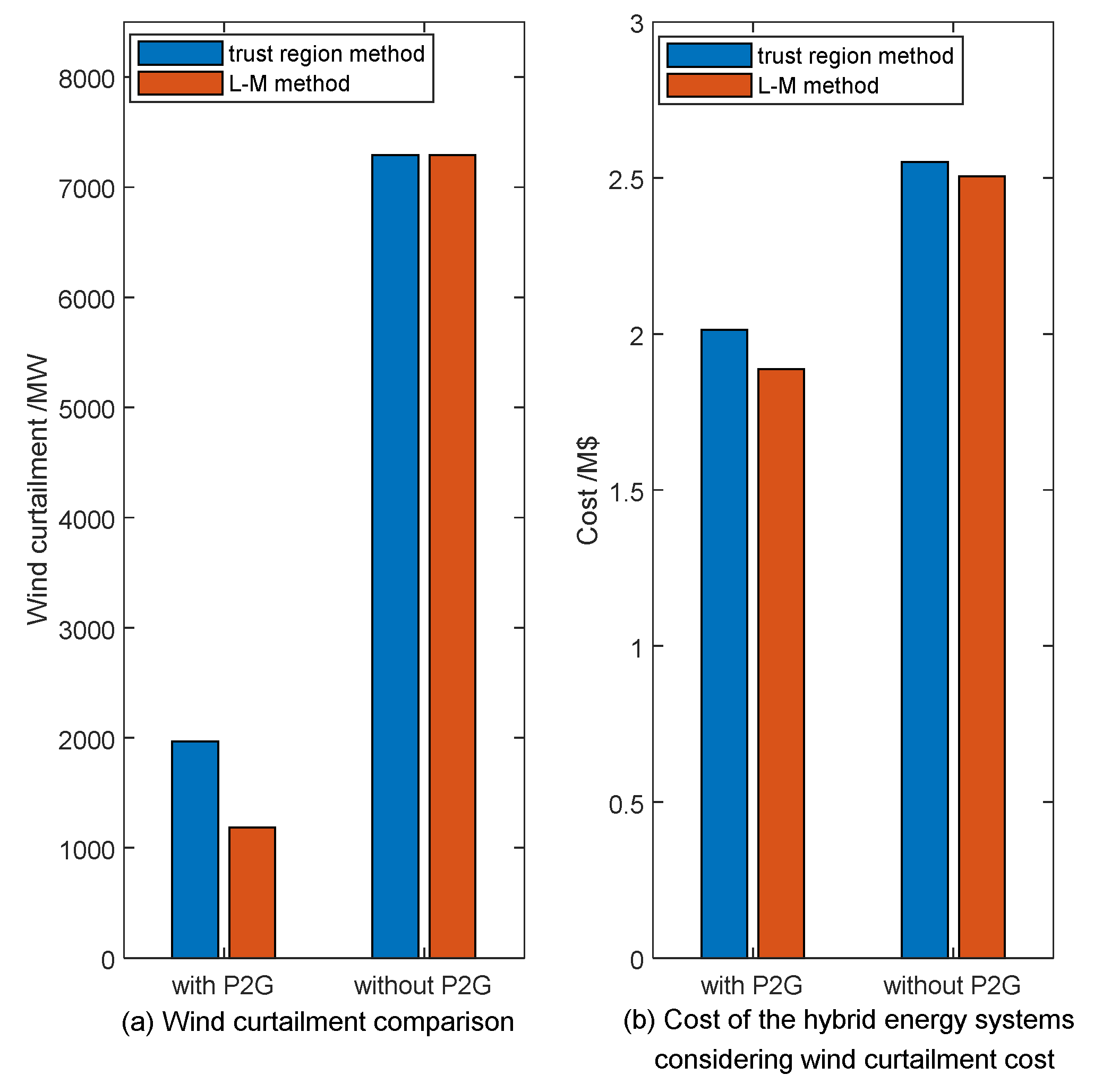
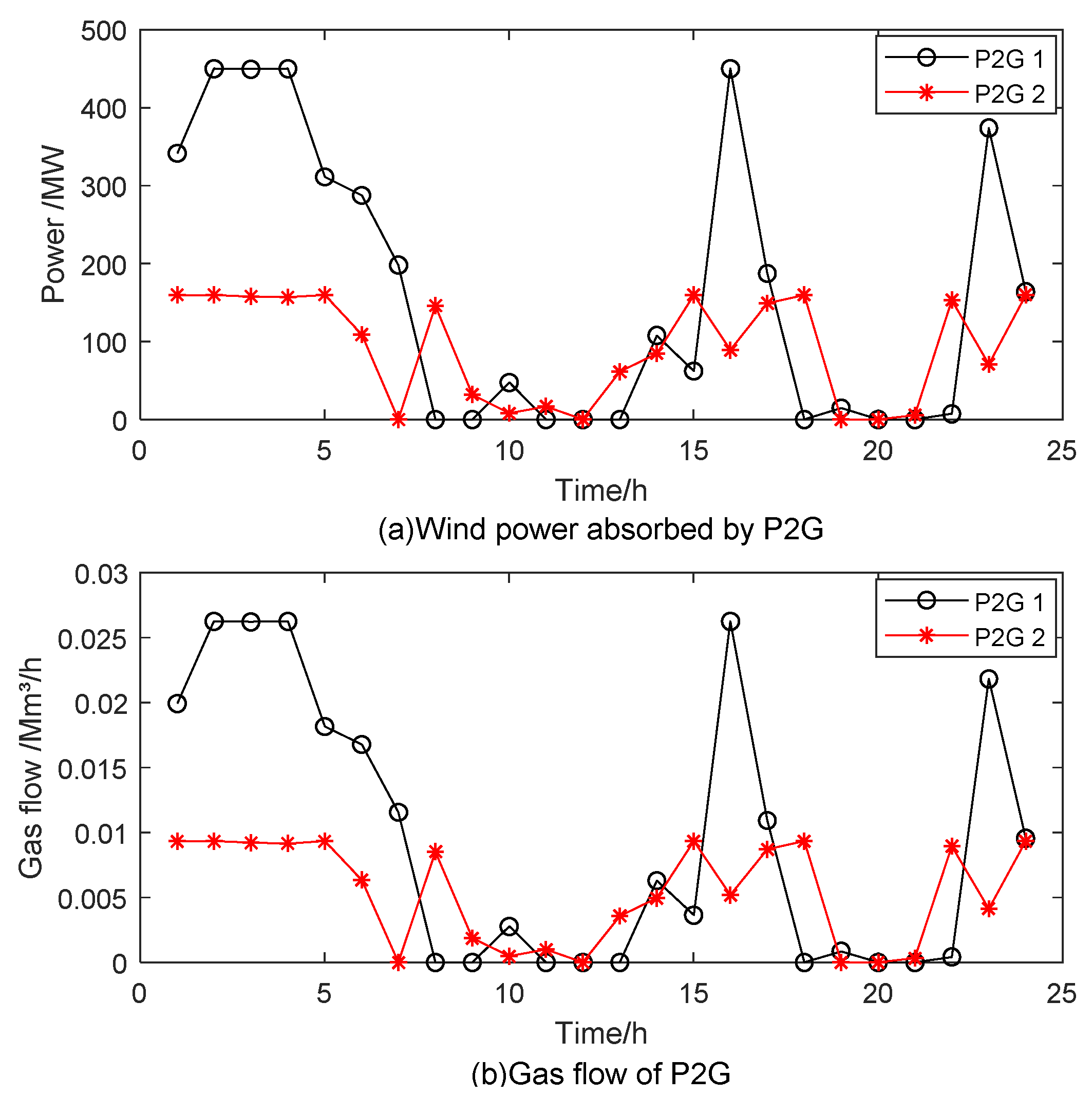

| Power Units | Pmax/MW | Pmin/MW | Ramp Up Rate/MW/h | Ramp Down Rate/MW/h |
|---|---|---|---|---|
| Coal-fired unit 1 | 470 | 150 | 80 | 80 |
| Coal-fired unit 2 | 470 | 135 | 80 | 80 |
| Coal-fired unit 3 | 340 | 73 | 80 | 80 |
| Coal-fired unit 4 | 300 | 60 | 50 | 50 |
| Coal-fired unit 5 | 243 | 73 | 50 | 50 |
| Gas-fired unit 1 | 260 | 0 | 260 | 260 |
| Gas-fired unit 2 | 230 | 0 | 230 | 230 |
| Gas-fired unit 3 | 220 | 0 | 220 | 220 |
| Wind power unit 1 | 750 | 0 | 750 | 750 |
| Wind power unit 2 | 620 | 0 | 620 | 620 |
| Gas Storage No. | Initial Capacity/Mm3 | Max Capacity/Mm3 | Min Capacity/Mm3 | Max Gas Flow/Mm3/h | Min Gas Flow/Mm3/h |
|---|---|---|---|---|---|
| Gas Storage 1 | 1.5 | 3.5 | 0 | 0.35 | -0.20 |
| Gas Storage 2 | 2.0 | 4.5 | 0 | 0.45 | -0.25 |
| Gas Storage 3 | 1.5 | 3.5 | 0 | 0.35 | -0.25 |
| Node No. | 1 | 2 | 3 | 4 | 5 | 6 | 7 | 8 | 9 | 10 | 11 | 12 | 13 | 14 | 15 | 16 | 17 | 18 | 19 | 20 |
|---|---|---|---|---|---|---|---|---|---|---|---|---|---|---|---|---|---|---|---|---|
| Mmin/bar | 30 | 30 | 30 | 30 | 10 | 10 | 30 | 30 | 50 | 50 | 30 | 30 | 30 | 30 | 15 | 15 | 25 | 25 | 15 | 15 |
| Mmax/bar | 100 | 100 | 100 | 80 | 80 | 80 | 80 | 70 | 70 | 77 | 70 | 70 | 70 | 70 | 70 | 70 | 70 | 70 | 70 | 70 |
| Time/h | 1 | 2 | 3 | 4 | 5 | 6 | 7 | 8 | 9 | 10 | 11 | 12 |
| Power demand/MW/h | 1272 | 1188 | 1104 | 960 | 1080 | 1320 | 1476 | 1584 | 1740 | 1776 | 1800 | 1860 |
| Gas demand/Mm3/h | 1.03 | 0.97 | 0.92 | 0.98 | 0.99 | 1.03 | 1.23 | 1.45 | 1.79 | 1.83 | 1.74 | 1.61 |
| Time/h | 13 | 14 | 15 | 16 | 17 | 18 | 19 | 20 | 21 | 22 | 23 | 24 |
| Power demand/MW/h | 1680 | 1560 | 1320 | 1104 | 1416 | 1680 | 1800 | 2040 | 1860 | 1632 | 1344 | 1116 |
| Gas demand/Mm3/h | 1.46 | 1.42 | 1.39 | 1.38 | 1.39 | 1.30 | 1.26 | 1.19 | 1.15 | 1.15 | 1.12 | 0.97 |
| Case Studies | Fuel Cost (M$) | SOx Emission (ton) |
|---|---|---|
| Without P2G | 1.080 | 38.193 |
| With P2G | 1.084 | 37.939 |
| Case Studies | Methods | Cost of Natural-Gas/M$ | CO2 Emission/104 ton | Rate of Abandoned Wind Power | Operation Cost of P2G/M$ | Absorbed CO2 by the Methanation Process/104 ton | Increased Wind Power by P2G/MWh |
|---|---|---|---|---|---|---|---|
| Without P2G | Trust Region | 0.741 | 5.791 | 24.85% | 0 | 0 | 0 |
| L-M | 0.695 | 5.790 | 24.85% | 0 | 0 | 0 | |
| With P2G | Trust Region | 0.732 | 5.727 | 6.71% | 0.106 | 0.056 | 5321.66 |
| L-M | 0.685 | 5.491 | 4.04% | 0.122 | 0.064 | 6104.48 |
© 2019 by the authors. Licensee MDPI, Basel, Switzerland. This article is an open access article distributed under the terms and conditions of the Creative Commons Attribution (CC BY) license (http://creativecommons.org/licenses/by/4.0/).
Share and Cite
Liu, J.; Sun, W.; Harrison, G.P. Optimal Low-Carbon Economic Environmental Dispatch of Hybrid Electricity-Natural Gas Energy Systems Considering P2G. Energies 2019, 12, 1355. https://doi.org/10.3390/en12071355
Liu J, Sun W, Harrison GP. Optimal Low-Carbon Economic Environmental Dispatch of Hybrid Electricity-Natural Gas Energy Systems Considering P2G. Energies. 2019; 12(7):1355. https://doi.org/10.3390/en12071355
Chicago/Turabian StyleLiu, Jing, Wei Sun, and Gareth P. Harrison. 2019. "Optimal Low-Carbon Economic Environmental Dispatch of Hybrid Electricity-Natural Gas Energy Systems Considering P2G" Energies 12, no. 7: 1355. https://doi.org/10.3390/en12071355
APA StyleLiu, J., Sun, W., & Harrison, G. P. (2019). Optimal Low-Carbon Economic Environmental Dispatch of Hybrid Electricity-Natural Gas Energy Systems Considering P2G. Energies, 12(7), 1355. https://doi.org/10.3390/en12071355





